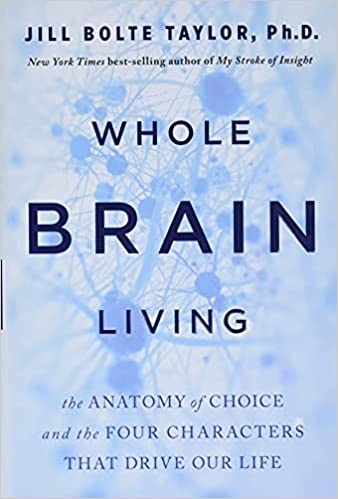
You know that nagging voice in your head that scares you out of trying something new, or castigates you for making a mistake, or lashes out at a loved one? I’m sure we’ve all struggled to deal with this aspect of our personalities. In her new book Whole Brain Living Jill Bolte Taylor, a neuroanatomist, pinpoints which section of the brain those negative voices arise from. She explains that our brains contain four separate personalities (she calls them “characters”), and she suggests ways to help all four sections work together to acknowledge and overcome negative feelings and to shift into a more constructive, enlightened mindset.
I first became aware of Jill Bolte Taylor when I saw her TED talk, “My Stroke of Insight,” in which she describes how her perceptions changed when her left brain hemisphere was damaged due to a stroke and she was operating mainly with her right hemisphere. I’m interested in the connection between brain hemispheres and creativity, and I loved her TED talk, complete with a preserved human brain as a visual prop.
Taylor’s new book does touch on the fact that the right hemisphere is the seat of creativity, but she goes much farther. She declares that the right brain is actually our connection to God or spirituality. During her stroke, Taylor was no longer able to distinguish where she ended and the rest of the universe began. “Instead of a physical being, I experienced myself to be an energy ball that was as big as the universe. Shifted into this consciousness of my right brain, I perceived the essence of myself as enormous and expansive, and my spirit soared free” (p. 6).
The book begins with some simple brain anatomy and an introduction to the four “characters”: left brain emotional (the source of all that negative chatter); left brain thinking (methodical, past and future oriented, individualistic); right brain emotional (fearless, friendly, creative); and right brain thinking (wholistic, collective, in the flow of the present moment). Part II goes into greater detail about the four characters, including sections to help the reader analyze and even give a name to each of their own characters. Taylor then explains the “brain huddle,” a way for the four characters to meet, acknowledge each other’s feelings, thoughts, and purposes, and come up with a strategy to move ahead. Part III analyzes how the four characters deal with physical health issues, romantic relationships, addiction, and technology.
I found this book enlightening. I have always suspected that, when I shifted into my right brain “creative” mode, I was connecting with a higher power or with the intelligence of the universe. Taylor gives scientific evidence of this connection.
The book also helped me immediately implement instructions for the “brain huddle.” I tend to have random guilty thoughts or to fear that I’ve unknowingly made a grave mistake. I sometimes find myself repeating “I’m sorry, I’m sorry” in my own mind, without knowing what I am sorry about. In the past, I would try to ignore these feelings, or would berate myself further for these pointless emotions. With Taylor’s instructions, the next time this happened, I was able to recognize these negative thoughts as the immature attempts of my left emotional brain to protect me. Then I was able to consciously have my left thinking brain acknowledge the fears of the left emotional brain, and ask, is there anything I’ve done that I need to make amends for? Upon realizing that there was nothing at that moment, I was able to let go of these negative guilty feelings.
My left thinking brain says of this book: I like it because it is clear, logical, and practical. My left emotional brain says: thank you for understanding and appreciating my work. My right hemisphere doesn’t say anything because it has no language, but it feels appreciated and excited to lead me into more connection, creativity, kindness, fun, and wholeness.
